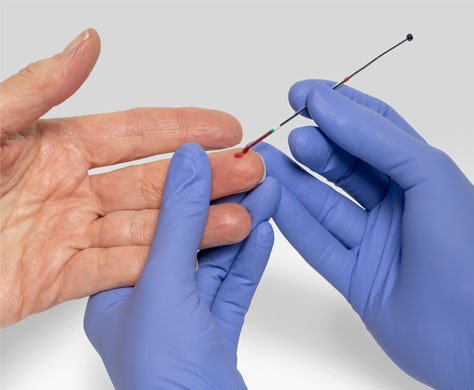How do you achieve good results from a PT/INR test? To help, we’ve developed a list of Do’s and Don’ts for a successful PT/INR test using the Coag-Sense® PT/INR Monitoring System.
What is a PT/INR Test?
A Prothrombin Time (PT) is reported in seconds and in International Normalized Ratio (INR) units. Using an in-vitro diagnostic device such as the Coag-Sense® PT/INR Monitoring System requires fresh capillary whole blood from a fingerstick. The device is intended for use by health care professionals at the point of care to regularly monitor patients on warfarin-type anticoagulation therapy. It may also be used at home by a motivated self-tester.
The Coag-Sense® PT/INR Monitoring System uses our patented Direct Clot Technology to measure INR. The result shown is the actual clot time and is available in less than one minute. For optimal management, the goal for patients is to remain within their targeted INR therapeutic range 65% of the time. The risk of blood clots increases if INR is too low. If INR is too high the risk of hemorrhaging increases. The overarching objective for patients on anticoagulation medications is to avoid unwanted clots that could lead to serious health issues.
Do’s and Don’ts for a successful PT/INR test
Do:
- Ensure that the test strip is not past its expiration date. The Coag-Sense® PT/INR Meter will not produce a result if the test strip has passed its expiration date.
- Apply blood samples to the test strip immediately after collection. Once the blood begins to clot, results are unreliable.
- Test using a minimum volume of 10 µl of blood. A low sample volume may trigger an error message.
- Wash the fingerstick site with warm water and soap and dry completely. Oils, lotions, or dirt may cause unreliable results.
- Use the transfer tube to ensure the correct volume of sample is drawn. Capillary action will draw the appropriate amount into the transfer tube.
- Start the test over if you notice a bubble in the blood sample in the transfer tube. Air bubbles will cause unreliable results.
- Use only the power adapter provided with the Coag-Sense® PT/INR Meter. The meter has a built-in rechargeable lithium polymer battery. Damage may result from an inappropriate adapter.
- Handle with care. The Coag-Sense® is a delicate instrument. Dropping or mishandling the meter may cause damage.
- Store the meter in a cool, dry place in the zippered pouch provided.
- Dispose of used materials, considered potentially infectious in puncture resistant biohazard waste containers following universal precautions.
Don’t:
- Squeeze the fingerstick site excessively. Milking releases interstitial “tissue layer” fluid that can cause unreliable results.
- Use Isopropyl Alcohol or chlorohexidine gluconate wipes. If any alcohol or chlorohexidine gluconate remains on the finger, results may be unreliable.
- Use the same finger if you need to repeat a test. Blood may have already started to clot on the first finger and could cause unreliable results.
- Re-use test strips. Test strips are designed for a single use only.
- Allow liquids to spill on the meter or place the meter in liquid. Use only Healthcare Bleach Germicidal Wipes containing Sodium Hypochlorite to clean exposed surfaces for a contact time of one minute.
- Touch or move the meter while it is running a test. Movement may cause unreliable results.
- Pull the strip out while the wheel is turning. Instead, press STOP. When the meter displays “Test Cancelled, Remove Strip,” the strip may be removed.
- Use adjacent to or stacked near any other equipment. Portable and mobile RF communication equipment may affect the Coag-Sense® PT/INR Meter.
- Attempt to open or repair the meter yourself. There are no user serviceable parts inside.
Use this list of Do’s and Don’ts as a guide for a successful PT/INR test with the Coag-Sense® PT/INR Monitoring System. For more details about the proper use of the system, please refer to the package insert included in the Test Strip Kit or the user manual provided with the meter or click here.


